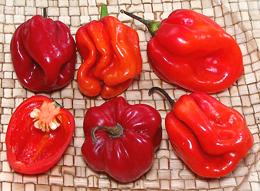
This region is known for liberal use of stingingly hot chilis, but also includes some that are surprisingly mild. Some of these chilis have been carried far and wide, to the extent the predominant chilis in West Africa are the Caribbean Habanero and Scotch Bonnet..
We include here all the islands of the Caribbean, despite their differences. While most make liberal use of hot chilis, Cuba, Dominican Republic and Puerto Rico favor mild chilis. We also include the mainland countries of Guyana, Suriname, and French Guiana. Their populations are concentrated on the Caribbean Coast, and they are inextricably tied to the cultures and cuisines of the Caribbean. They are in the Hot Chilis camp.
More on Chili Peppers.
Some chilis of the region are called "Aji" (pronounced Ah-hee). This word is from the Taino word "axí". The Taino were the original inhabitants of much of the Caribbean, but were driven almost extinct by Spanish cruelty and diseases they brought.
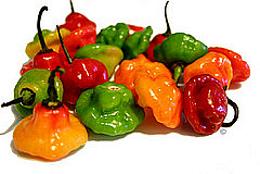 [Aji Cachucha, Ajicito; C. chinense]
[Aji Cachucha, Ajicito; C. chinense]
This chili is a variety of the fiercely hot Scotch Bonnet, but very mild.
It still has the tropical fruity taste of the Scotch Bonnets and
Habaneros. It is much used in Puerto Rico, Cuba and Dominican Republic
where hot chilis are not much appreciated. In South America it is most
widely used in Venezuela, but also in Colombia on the Caribbean coast.
In some recipes of this coastal region, a number of Aji Dulce will be
combined with one hot Scotch Bonnet or Habanero.
Photo by Portorricensis contributed to the Public Domain
.
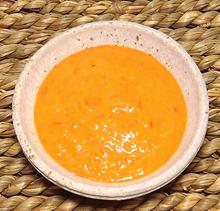 [Pasta de Aji Dulce]
[Pasta de Aji Dulce]
While fresh Aji Dulce Chilis are hard to acquire in most regions, and do
not store long, there is an Aji Dulce Paste available on-line, made in
Venezuela. Ing: Sweet Peppers, Onions, Beet, Garlic, salt, vegetable oil
(soybean), vinegar, citric acid.
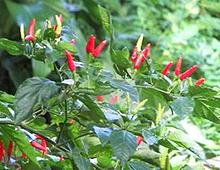 [Gentlemen's Pepper; Aji Picante (Puerto Rico) C. frutescens]
[Gentlemen's Pepper; Aji Picante (Puerto Rico) C. frutescens]
This Chili is unusual in having such a low hotness level for a
C. frutescens Bird Pepper (Scoville 30,000 to 35,000 - most are
Scoville 100,000 and up). In Puerto Rico, this is the preferred chili for
the essential table condiment Pique. It is not always available even there,
so chilis like the Jamaican Bird Pepper are
also used. Here in North America, we will use the ubiquitous
Thai Chili, closer to the Jamaican in
hotness.
Photo by Portorricensis contributed to the Public Domain
.
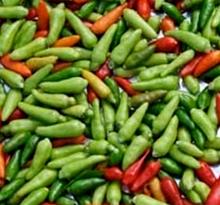 [Jamaican Bird Pepper; C. annum,
C. annum]
[Jamaican Bird Pepper; C. annum,
C. annum]
This Chili is unusual in that it ripens point-up like other Bird Peppers,
but is C. annum rather than C. frutescens. It is used in Jamaica
where it first became popular, but is also used elsewhere in the Caribbean
where hot chilis are enjoyed. It's heat level is
H9. The C. frutescens Bird Chilis are generally
H10 and produce for many years, while
the Jamaican will produce for only one year. Bird Chilis of any kind are not
much available in North America, so here everyone uses the ubiquitous
Thai Chili, which is a Cayenne type, as
is the Jamaican, and is similarly hot.
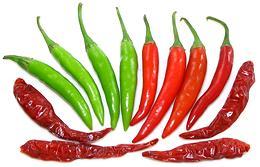 [Rat Turd Chili; Mak Pet Ki Nuu (Laos); Nga Yut Thee (Burma); Scuds
(some chefs); C. annuum]
[Rat Turd Chili; Mak Pet Ki Nuu (Laos); Nga Yut Thee (Burma); Scuds
(some chefs); C. annuum]
Not a Carribean Chili. Thai Chilis are the chilis universally used as "small fresh chili", green or red, by all the ethnic communities here in Southern California. It is also displacing Bird Chilis in other parts of the world due to being easier to grow and harvest, so it's probably grown in the Caribbean by now.
It is small, often less than 1-3/4 inches long as grown in Thailand,
but there are many varieties and those grown in California are often up
to 2-3/4 inches (more efficient to grow and harvest larger sizes). They
are narrow, pointy and start growing point up, but turn downward as they
reach full size. They turn from green to red when ripe (they may be
somewhat orange in between). They are very hot (
H8 to H9), slightly less hot when red ripe, and a little less than
that when dried. Fully red ripe prik ki nu dry very well. Those imported from
Thailand tend to be hotter than if you dried those grown in California.
Some minor varieties are black if in full sun, turning bright orange when
ripe.
 [Italian Frying Pepper; C. annuum]
[Italian Frying Pepper; C. annuum]
This chili is very much favored in Puerto Rico, the Dominican Republic, Cuba,
and Venezuela, regions where hot chilis are not appreciated. It can surprise,
though. While usually solidly within
H1,it can occasionally get to the high end of
H2. They are usually harvested while
still yellow-green, but turn bright red if allowed to fully ripen. They have
rather thin walls and thin skins, and grow to about 6 inches long.
For details and substitutes, see our
Cubanelle Chili page. Photo
by United States Department of Agriculture = public domain.
 [C. chinense]
[C. chinense]
Originally from the Yucatán of Mexico, These extremely hot chilis
(H10) are one of the most
important chilis in the Caribbean Islands, and are similarly important
along the Caribbean coast. They come in Green, Red, Orange and Yellow,
with White, Purple and "Chocolate" varieties known. Shape can vary
radically. Those most commonly sold here in Southern California are
wrinkly and bright orange. The name Habanero, "of Havana", comes from
a time when they were shipped from that port. They are little used
in Cuba today, as hot chilis are out of style there now.
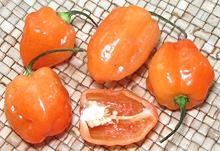 [C. chinense]
[C. chinense]
If you live in Southern California, this Orange Habanero is what you will
be using. It totally dominates the market here, and other varieties are
seldom seen. On the other hand, I haven't heard any complaints about that.
Every market serving a Latino community has a bin of them, and Asian markets
have at least foam trays of them. Apparently they are considered adequate for
the job - high heat and good fruity flavor.
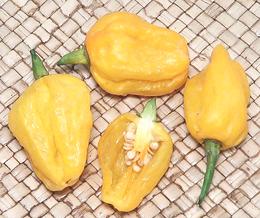 [Bonnie Pepper, Scotty Pepper; Ball-of-fire (Guyana); Aji Chombo
(Panama); C. chinense]
[Bonnie Pepper, Scotty Pepper; Ball-of-fire (Guyana); Aji Chombo
(Panama); C. chinense]
This chili is often confused with the Habanero. To tell the difference, you apparently have to be Jamaican - so, just to be sure, I bought seeds certified as Scotch Bonnet by a Jamaican agricultural organization. These are yellow, but Scotch Bonnets also come in red. They are the same hotness (H10) as the Habanero, but with a somewhat sweeter and smokier flavor. My plant did nothing its first year, but was very productive in the second year.
In appearance, they are usually more rumpled than the Habanero. They
got their name from a once common variety in Jamaica that was of a
flattened rumpled disk shape, said to look like a Scottish bonnet. Today,
due to the meddling of chili growers, they come in many shapes, colors
and levels of hotness. This is the preferred chili for making jerk meat
in Jamaica, as well as some hot sauces there, but are now grown all over
the region. The largest in the photo was 1.7 inches long and 1.3 inches
diameter.
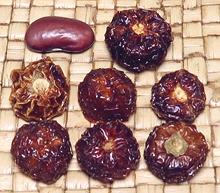 [Guyana Pepper, Bird Pepper; C. Frutescens]
[Guyana Pepper, Bird Pepper; C. Frutescens]
This chili is very popular in Guyana, and used in a great many recipes there.
It is near the low end (usually) of
H10 and has a fruity flavor similar to the Scotch Bonnet. In
Guyana it is usually used fresh, when ripe and bright red, but in most of
North America we can get only dried. Fresh, they are about 1/2 inch diameter,
and grow upright on their stems, as do other Bird Peppers. Subst:
Scotch Bonnet or Habanero, both quite similar in hotness and taste, but
different size and shape.
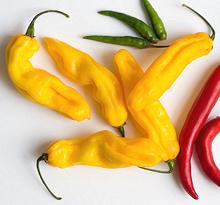 [Suriname Pepper; C. chinense]
[Suriname Pepper; C. chinense]
This very hot chili (H10) is
the most important chili in Suriname. Related to the Habanero, it is
just about as hot, but more aromatic in cooking. The taste is said
to have hints of pineapple and mango - but the main feature of this
chili its full mouth hotness. They come in Yellow and Red, and vary
greatly in shape, from long and curved to pumpkin shape, but always
a bit wrinkled. It is thought it's name is that of a local prostitute
(apparently very hot).
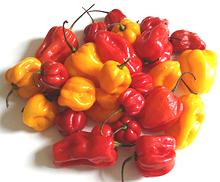 [Aji Umba, Dji Oema Ning (Suriname (lit. "Your name is woman"));
C. chinense]
[Aji Umba, Dji Oema Ning (Suriname (lit. "Your name is woman"));
C. chinense]
This extremely hot chili (H10),
originally from Brazil, is almost as important as the Madame Jeanette
in Suriname. It's size, shape and color are confusing, so it is often
sold as Habanero, Scotch Bonnet, or even Madame Jeanette. It is less
aromatic than Madame Jeanette.
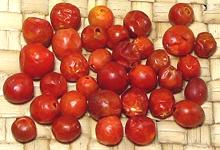 [Chiltepe, Chili Tepin; C. annuum]
[Chiltepe, Chili Tepin; C. annuum]
These tiny (up to about 0.35 inch dried) but intensely hot
(H9) chilis possibly arose in
Bolivia and southern Brazil, and were scattered throughout Central and South
America and the Caribbean by birds long before humans invaded the Americas.
They are found as far north Arizona and New Mexico and are still harvested
wild (thus are quite expensive - 2022 U.S. $11.96 / ounce in 1/4 ounce
bags). They are valued for their heat, complex flavor and medicinal uses.
Their intense heat is sudden, but not long lasting, while that of the
related Pequin builds more
slowly but lasts longer.